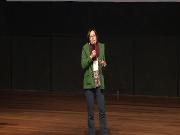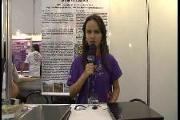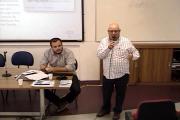Pesquisa realizada pelo termo "yan"

3º Congresso de Graduação da USP - Mesa Redonda 1: Ensinando com Aprendizagem Ativa - Profª Chao Yun Irene Yan (ICB)
O Congresso de Graduação da USP é um fórum dedicado a professores partilharem suas experiências e inovações no ensino de graduação. Essa iniciativa da Pró-reitoria de Graduação chega em sua 3ª edição e a repercussão dos anos anteriores demonstra que o evento já se consolida como uma referência no ensino de graduação.
A diversidade presente na Universidade de São Paulo e nas demais instituições de ensiono superior públicas, não só pelas diferentes áreas do conhecimento, mas pela coexistência das mais variadas concepções, valores e práticas no espaço acadêmico, faz do Congresso de Graduação da USP um ponto focal importante para debater, explorar, reelaborar e aprimorar o ensino de graduação.
O lema dessa 3ª edição - "boas ideias devem ser compartilhadas" - reforça a ideia central estabelecida desde a concepção do Congresso de Graduação: compartilhar experiências!
Duração: 00:24:04

A potencialização das hortas orgânicas através do modelo da mandalla alelopática
Projeto apresentado na FEBRACE 2010. Área de Ciências Agrárias. Adriana Jacinto da Silva, Yêda Resende Carvalho, Barbara Yanara da Silva, Guilherme Augusto da Costa (Orientador), Colégio Estadual Hermogenes Coelho, Aracu - GO
Duração: 00:01:12

Arte Hoje, e o pós – pós – Duchamp
Mesa 2 - Arte Hoje, e o pós – pós – Duchamp
Uma discussão sobre a arte contemporânea e os reflexos das ações duchampianas .
Com Paulo Herkenhoff e Camilo Yáñez
Mediação: Martin Grossmann
Mais informações em: www.forumpermanente.org
Duração: 01:53:17

Colóquio Ifusp: Center for Underground Physics, Institute for Basic Science - Daejeon, Korea
It is well known to scientists that 95% of the universe is composed of unknown dark energy and dark matter. Among them, dark matter, which accounts for 27% of the universe, has been confirmed by astronomical observations, but it has not yet been observed yet by direct observation. Among the candidates for dark matter, WIMP (a weakly interacting massive particle) is one of the most stringent candidates, and has been searching competitively in underground laboratories around the world. In Korea, the COSINE collaboration is carrying out the world-class dark matter search experiment by establishing the COSINE-100 experiment in the Yangyang underground laboratory with the joint research team of USA, UK, Brazil and Indonesia. In Korea, we plan to build a new underground laboratory in Jeongseon county by 2020 to continue searching for dark matter. In this presentation, I will briefly introduce the dark matter and show the ongoing researches on deep underground laboratories in the world and show the efforts and accomplishments in Korea.
Duração: 01:04:57

Colóquios do IFSC - Bóson de Higgs, uma longa caminhada: do papel ao anel, do anel ao Nobel
A discussão sobre bósons escalares em conexão com as partículas elementares iniciou-se na década de '30, com Fermi, Majorana, Pauli e Weisskopf. Na década de '50, Salam resolve algumas questões teóricas e compreende, com o advento das teorias de Yang-Mills-Shaw, o papel de campos escalares na base da compreensão de um mecanismo para a geração das massas para as partículas fundamentais.
Com as contribuições decisivas de Brout, Englert e Higgs, por um lado, Guralnik, Hagen e Kibble, por outro lado, consolida-se a física de uma nova partícula escalar, considerada elementar, o Bóson de Higgs. Estabelece-se a Teoria Eletrofraca e emerge, posteriormente, o Modelo-Padrão da Física de Partículas. Com isto, tem início também a era dos grandes aceleradores.
Do SPS ao LEP e do LEP ao LHC, o Modelo-Padrão vem sendo testado com precisões sempre mais altas e suas extensões - uma nova física acima da escala eletrofraca - estão sendo colocadas à prova. Dentre estas, a teoria realmente sub judice é a Supersimetria (SUSY).
Será discutida a relação entre a SUSY e o Bóson de Higgs e, sobretudo, o esforço maior será concentrado na identificação desta nova partícula e na apresentação do real status da SUSY como uma possível nova física além do Modelo-Padrão após os 3 primeiros anos de operação do LHC.
Duração: 02:52:09

COMU - Dr Rafael Yanes - Suporte Avancado Vida Pediatria
""
Duração: 00:36:02

Intercontinental Academia - Liu Yangyang
Participant presentation
The Institute of Advanced Studies of the University of São Paulo (IEA-USP) and the Institute for Advanced Research of the University of Nagoya (IAR) are leading a inter-institutional, interdisciplinary and global project: the Intercontinental Academia (ICA).
An initiative of the UBIAS network, the ICA will bring together 15 young researchers from different nationalities and areas of knowledge to develop studies on "time."
During two immersion meetings, one from April 17 to 29, 2015, in São Paulo, and another one in January and February, 2016, in Nagoya, the group will participate in conferences, workshops and debates.
Duração: 00:03:10

The heritability of human height
#28;The heritability of human height
Dr. Bruce Weir,
Professor and Chair, of the Department of Biostatistics,
University of Washington in Seattle.
#29;
Abstract:
In 1886 Francis Galton published data on heights for people and their parents. He showed that people#25;s heights tended to be closer to the population mean height than was the average of their parents#25; heights, introducing the concept of #28;regression to the mean.#29; He went on to show that the relationship between the heights of pairs of people depends on the degree of relatedness between the pair. His work was replicated by Karl Pearson in 1903, three years after the rediscovery of Mendel#25;s Laws and #28;in the present controversial phase of the theory of heredity.#29; With the introduction of quantitative genetic models (and the analysis of variance) by R.A. Fisher in 1918 we now express the correlation in heights for pairs of people in terms of their relatedness and the heritability of height. Heritability of a trait is the portion of variance in trait values that has an (additive) genetic component. By measuring heights on pairs of people of known family relatedness, geneticists have estimated the heritability of human height to be about 0.80. The recent flurry of genome-wide association studies has revealed many genetic markers, SNPs, as - associated with height #19; a 2010 publication listed 135 from a meta-analysis of 133,653 heights. However, these SNPs collectively accounted for only 10% of the variation in height and the search began for the #28;missing heritability.#29; Using data from the GENEVA pro ject that have been processed in our department, P.M. Visscher has extended the early work of Galton, Pearson and Fisher by using all the SNPs scored in a genome-wide scan, and by using measures of relatedness estimated from these SNPs instead of being inferred from family history. He could account for 45% of the variation. I will explain his approach (Yang et al., Nature Genetics 43:519#19;525, 2011) and suggest ways to account for the remaining 35%.
Duração: 01:09:00

V SEMINÁRIO DE PESQUISA DA ECA - MESA I
MESA I - COMUNICAÇÃO E O DESENHO DE UM CAMPO COMUM (27/04/2015)
Coordenação: PROFA. DRA. CRISTINA COSTA
- Roseli Aparecida Fígaro Paulino (Centro de Pesquisa em Comunicação e Trabalho)
- Luciano Victor Barros Maluly (Grupo de Pesquisa em Jornalismo Popular e Alternativo)
- Débora Cordeiro Braga (CETES - Centro de Estudos de Turismo e Desenvolvimento
Social)
- Mitsuru Higuchi Yanaze (CEACOM-CE de Avaliação e Mensuração em Com.e Marketing)
Duração: 01:04:18
 Carregando
Carregando





